A tragic incident in 1983 shocked the world and led to significant safety improvements in offshore drilling. On that fateful day, the Byford Dolphin oil rig in Norway became the site of one of the most horrific accidents in the history of the industry. This incident, now known as the Byford Dolphin disaster, claimed the lives of five divers, leaving a lasting impact on their families and sparking important changes in diving protocols.

The Byford Dolphin was a semi-submersible drilling rig stationed in the North Sea. Among its crew were saturation divers, professionals who performed maintenance work on offshore oil rigs and undersea pipelines at depths reaching 500 feet or more. Unlike regular divers who resurface after a few hours, saturation divers could spend up to 28 days at a time, living in high-pressure chambers between shifts.
On November 5, 1983, tragedy struck when a routine procedure went horribly wrong. As experienced tender William Crammond connected the diving bell to the living chambers, disaster struck. The diving bell detached prematurely, causing explosive decompression. The resulting rush of air killed Crammond and injured his colleague, while the four saturation divers inside the chamber met a gruesome fate.

Autopsy reports revealed that three of the divers, Edwin Arthur Coward, Roy P. Lucas, and Bjørn Giæver Bergersen, were essentially “boiled” from the inside as nitrogen bubbles erupted in their blood. Truls Hellevik, standing in front of a partially opened door, was tragically sucked out through a narrow opening, tearing his body apart and ejecting his internal organs onto the deck.
This horrifying incident exposed serious flaws in safety protocols, prompting significant improvements in commercial diving operations and safety standards worldwide. In response to the calls for further investigations by the families of the divers, the Norwegian government offered a settlement in 2009. However, it’s important to note that the incident caused severe distress for the families, as they initially received no support or compensation.
Since the Byford Dolphin disaster, modern offshore diving legislation and International Marine Contractors Association (IMCA) guidance have placed a strong emphasis on addressing “latent failures” in systems to minimize risks. One major flaw in the Byford Dolphin diving system was the absence of a suitable interlock, which played a significant role in causing the accident.
The tragic events on the Byford Dolphin ultimately led to positive changes in safety practices and regulations. Today, the lessons learned from this disaster continue to shape the offshore drilling industry, ensuring that the lives of divers are safeguarded to the best extent possible.





